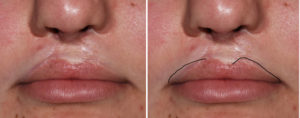The bilateral cleft lip deformity is challenging on many levels due to both loss and disruption of normal lip tissues. While the primary cleft lip repair in a baby is about creating a more normal looking cupid’s bow of adequate length and thickness (actually creating an intact upper lip), the older bilateral cleft lip patient has other less severe but nonetheless aesthetic troubling issues….upper ip asymmetry.
Almost always cleft lip patients have discrepancies in the two peaks of the cupid’s bow as well as the amount of vermilion exposure on each side of the upper lip. Even with good looking philtral scars, lip asymmetries are easily perceived even if they only have modest differences.
One very effective technique for improving the shape of the upper lip in cleft patients are vermilion advancements. Borrowing from its use in aesthetic lip surgery, they are the most powerful method of creating more vermilion exposure and balancing out upper lip asymmetries. While they do so at the tradeoff of a very fine line scar at the vermilion-cutaneous junction, their effectiveness at making a more harmonious lip shape is well worth it for the right patient.

The light red or pink color of the lips, in contrast to the more white surrounding skin, makes their shape very visible. Cleft patients in particular have an almost 100% occurrence of some upper lip asymmetry for understandable reasons due to both genetics and the effects of growth through a scarred upper lip repair. In the properly selected patient a cleft lip revision changing the position of the vermilion can have a very significant aesthetic benefit.
Dr. Barry Eppley
Indianapolis, Indiana




